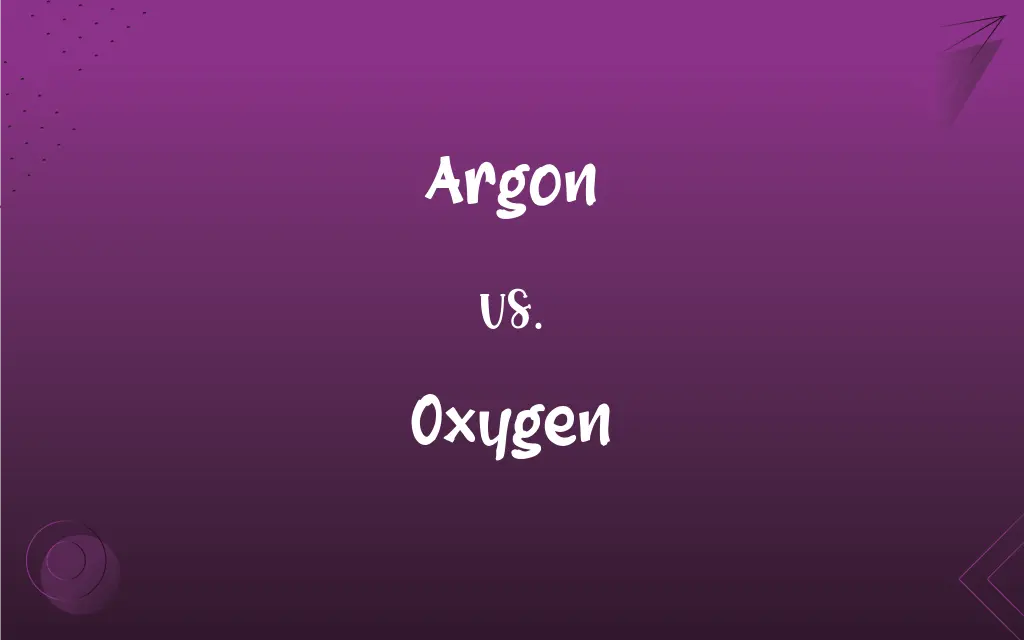Argon vs. Oxygen: What's the Difference?
Edited by Aimie Carlson || By Janet White || Published on December 16, 2023
Argon is an inert, colorless, odorless noble gas, while oxygen is a reactive gas essential for combustion and respiration.

Key Differences
Argon is a noble gas with atomic number 18, known for its chemical inertness. Oxygen, with atomic number 8, is a highly reactive element, crucial for supporting life and combustion processes.
Argon, constituting about 0.93% of the Earth's atmosphere, is used in welding and lighting due to its non-reactive nature. Oxygen, making up approximately 21% of the atmosphere, is vital for breathing in animals and humans.
Argon is often used to create an inert atmosphere for scientific experiments and preservation, while oxygen is used in medical applications, metal cutting, and as an oxidizer in rocket fuel.
Argon, being heavier than air, tends to accumulate at the bottom in enclosed spaces, posing an asphyxiation risk in large concentrations. Oxygen, although essential for life, can be dangerous in excessive amounts, leading to oxidative stress or fire hazards.
In the periodic table, argon belongs to the noble gases group, known for their full valence electron shells and low reactivity. Oxygen, part of the chalcogen group, is known for its ability to form compounds with almost all other elements.
ADVERTISEMENT
Comparison Chart
Atomic Number
18
8
Role in Atmosphere
Inert, minor component (0.93%)
Reactive, major component (21%)
Chemical Reactivity
Chemically inert
Highly reactive
Common Uses
Welding, lighting, preserving inert atmosphere
Respiration, combustion, medical applications
Hazards
Asphyxiation in high concentrations
Fire hazard, oxidative stress in excess
ADVERTISEMENT
Argon and Oxygen Definitions
Argon
Gas used in lighting and electronics.
Argon is filled in incandescent light bulbs to prolong their life.
Oxygen
Gas used in combustion and respiration.
Oxygen supports the burning of fuels in engines.
Argon
A colorless, odorless noble gas.
Argon gas is often used in energy-efficient windows.
Oxygen
Vital component of the Earth's atmosphere.
Oxygen therapy is used for patients with respiratory issues.
Argon
Noble gas with atomic number 18.
Argon is a common component in the Earth's atmosphere.
Oxygen
Oxidizing agent in chemical reactions.
Oxygen is used in metal cutting processes.
Argon
Inert gas used in welding.
The welder used argon to shield the weld area from the air.
Oxygen
Element with atomic number 8.
Oxygen makes up a significant part of the Earth's crust.
Argon
Non-reactive atmospheric gas.
Argon is often used in wine preservation systems.
Oxygen
A reactive gas essential for life.
Plants release oxygen during photosynthesis.
Argon
A colorless, odorless, inert gaseous element constituting approximately one percent of the earth's atmosphere, from which it is commercially obtained by fractionation for use in electric light bulbs, fluorescent tubes, and radio vacuum tubes and as an inert gas shield in arc welding. Atomic number 18; atomic weight 39.948; melting point -189.36°C; boiling point -185.85°C. See Periodic Table.
Oxygen
A nonmetallic element constituting 21 percent of the atmosphere by volume that occurs as a diatomic gas, O2, and in many compounds such as water and silica, and in iron ore. It combines with most elements, is essential for plant and animal respiration, and is required for nearly all combustion. Ozone, O3, is an allotrope of this element. Atomic number 8; atomic weight 15.9994; melting point -218.79°C; boiling point -182.9°C; gas density at 0°C 1.429 grams per liter; valence 2. See Periodic Table.
Oxygen
The chemical element (symbol O) with an atomic number of 8 and relative atomic mass of 15.9994. It is a colorless and odorless gas. Category:en:Oxygen
Oxygen
Molecular oxygen (O2), a colorless, odorless gas at room temperature, also called dioxygen.
Oxygen
(medicine) A mixture of oxygen and other gases, administered to a patient to help them breathe.
Oxygen
(countable) An atom of this element.
Oxygen
(figurative) A condition or environment in which something can thrive.
Silence is the oxygen of shame.
They hoped to starve the terrorists of the oxygen of publicity.
Oxygen
A colorless, tasteless, odorless, gaseous element of atomic number 8, occurring in the free state in the atmosphere, of which it forms about 23 per cent by weight and about 21 per cent by volume, being slightly heavier than nitrogen. Symbol O. Atomic weight 15.9994.
Oxygen
Chlorine used in bleaching.
Oxygen
A nonmetallic bivalent element that is normally a colorless odorless tasteless nonflammable diatomic gas; constitutes 21 percent of the atmosphere by volume; the most abundant element in the earth's crust
FAQs
What is argon?
An inert, colorless, odorless noble gas.
What is oxygen?
A reactive gas crucial for life and combustion.
Is argon reactive?
No, it's one of the most chemically inert elements.
What are the main uses of oxygen?
In respiration, combustion, and medical therapies.
Why is oxygen essential for life?
It's required for cellular respiration in most organisms.
Is oxygen a pure element in the atmosphere?
It exists as a diatomic molecule (O2) in the atmosphere.
How is argon obtained?
Through the fractional distillation of liquid air.
Where is argon commonly used?
In welding, lighting, and creating inert atmospheres.
Is argon heavier than air?
Yes, it's denser than air.
Can oxygen be liquid at room temperature?
No, it requires extremely low temperatures to liquefy.
Can argon support combustion?
No, argon does not support combustion or life.
What safety precautions are needed when handling argon?
Ensure proper ventilation to prevent asphyxiation.
Why is oxygen important in hospitals?
It's used to support patients with breathing difficulties.
Does argon occur in the human body?
Only in trace amounts, with no functional role.
What happens if you breathe pure oxygen?
It can be harmful over time, causing lung damage.
Can argon be used in medicine?
Rarely, but it's sometimes used in cryosurgery.
What role does oxygen play in the water (H2O) molecule?
It's the central element forming water with hydrogen.
How does excessive oxygen affect the body?
It can cause oxidative stress and damage cells.
Are there any biological uses for argon?
Argon has no known significant biological role.
How does oxygen contribute to combustion?
It acts as an oxidizer, enabling fuels to burn.
About Author
Written by
Janet WhiteJanet White has been an esteemed writer and blogger for Difference Wiki. Holding a Master's degree in Science and Medical Journalism from the prestigious Boston University, she has consistently demonstrated her expertise and passion for her field. When she's not immersed in her work, Janet relishes her time exercising, delving into a good book, and cherishing moments with friends and family.
Edited by
Aimie CarlsonAimie Carlson, holding a master's degree in English literature, is a fervent English language enthusiast. She lends her writing talents to Difference Wiki, a prominent website that specializes in comparisons, offering readers insightful analyses that both captivate and inform.






































































